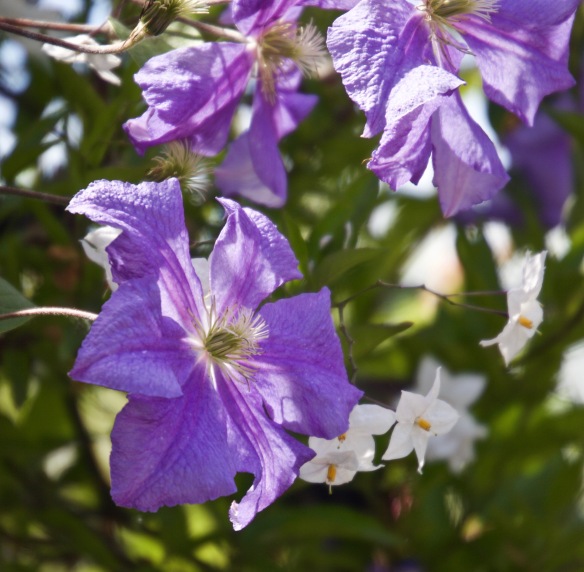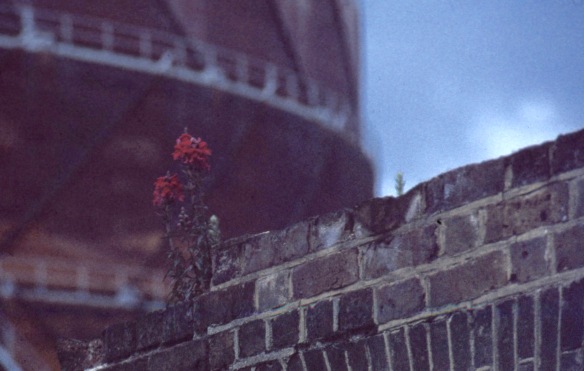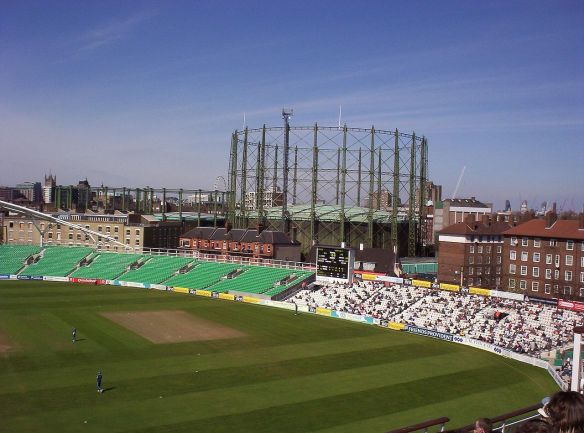CLICK ON IMAGES TO ENLARGE. REPEAT IF REQUIRED.
I forgot to mention yesterday that when I returned home I found that my cheque from Laithwaite’s had been delivered.
The Félicité Perpétue rose in the front garden has been sending thorny tentacles across the drive. This morning I restrained them with green wire.
Alongside the marguerites that accompany the rose,
a nasturtium trumpeted its presence.
Opposite, the clematis Mrs. N. Thompson and solanums
twine amongst the honeysuckle from which bees flit to and fro.
This new hollyhock is in bloom along the back drive.
In June 1981, I made a series of colour slides of gasometers. I scanned them this afternoon.
Here are sections of side views;
and one of a top.
There are glimpses of three in this image.
I cannot, for the life of me, remember where these were. Maybe the car wrecks could provide a pointer for anyone who may help identify them;
or maybe these snapdragons? Perhaps not.
The major problem for anyone attempting to assist is that these emblems of our industrial past may no longer exist.
This is what Wikipedia has to say about our gasometers: ‘A gas holder, sometimes called a gasometer, is a large container in which natural gas or town gas is stored near atmospheric pressure at ambient temperatures. The volume of the container follows the quantity of stored gas, with pressure coming from the weight of a movable cap. Typical volumes for large gasholders are about 50,000 cubic metres (1,800,000 cu ft), with 60 metres (200 ft) diameter structures.’
Today, there are very few left standing. The reason for this is described in this short video made by Tom Scott:
[youtube https://www.youtube.com/watch?v=SopJr0yHt-w&w=560&h=315]
One iconic gasometer, protected, or, listed since earlier this year, is visible from The Oval cricket ground. I spent many a day in the summers of my teens watching the rise and fall of this famous cricketing symbol. Wikipedia provides this photograph.
For our dinner this evening, the Culinary Queen produced smoked haddock, piquant cauliflower cheese (recipe), new potatoes, crunchy carrots, and sautéed leeks and peppers. We both drank Marlborough Oyster Bay sauvignon blanc 2015. Needless to say, it was all delicious.















The flowers are beautiful as always, Derrick. And the images and info on the gasometers is very interesting. I learn new things every day here in the blogosphere and I like that!
Thanks, very much, Lydia
Most interesting information. The scaffolding–when the gas is low– is quite delicately beautiful sculpture from a distance, and reminds me of the rides and roller coasters of an amusement park horizon.
Thanks, Cynthia. A nice analogy
I love gasometers too.
Thanks, Sol
I prefer the flowers 🙂 . A couple of years ago I visited Bangladesh several times for energy projects amongst others and saw these huge buildings. They are quite impressive but not my favourite architecture 😀
Thanks very much, Geetha 🙂
Welcome Derrick 🙂
I’ve never seen hollyhock, Derek..it’s beautiful. I’m happy to read Jackie got a promotion to ‘Culinary Queen.’ 🙂
Thanks very much, Jill
Yay to Jackie – a much deserved promotion. lol
Thanks, Jodie
That was interesting Derrick! I have seen that building at the Oval, but not known what it was. I love to see the marguerites in your garden, of all the flowers they are the ones that make me happiest – no idea why! I haven’t made a cauliflower cheese in a hundred years – I’m off to check out the Culinary Queen’s recipe! xo
Thank you very much, Pauline. I’m sure you will like it
Beautiful flowers–the hollyhock is especially stunning. Interesting information about the gasometers. I had no idea.
I’m glad you received your check. 🙂
Thanks very much, Merril
Industrial structures do make dramatic studies; I must open my eyes to them more often as subjects for photography. So often we dismiss them as eyesores.
Love the colour of that hollyhock, the petals remind me of the flounces of a lady’s dress. Carmen, perhaps.
Many thanks, Mary. Carmen is good
Great recipe. Good pictures of gasometers (and nice Morris Traveller on top of one of the heaps). Flowers aren’t bad either. 😉
Many thanks, Quercus
We used to look out over a gasometer in a first flat. Ah, those were the days…
That’s a great bee capture, Derrick.
Many thanks, Jenny
Oooh, before I got to the end of the post, I was thinking “There’s one in Kennington, near the Oval!”. Then I read on and saw you knew about it already. As a child, I used to live opposite it, and still pass it to this day.
Amazing, Persia. Had you been older, or I younger, our paths might have crossed. Thank you
Yes, indeed. I’m sure they would have. <3 By the way, did you ever smell the odour coming from the Beefeater Gin Factory? It was a short distance from the gasometer. One could get a little tipsy just from breathing!
Yes. You are right, Persia. I’d forgotten that
Love that bee shot! And the gasworks history is fabulous. I love the video and the shots of the gasometers. I used to belong to a group called the Society for Industrial Archeology (http://www.sia-web.org) whose logo is a gasworks building. Sometimes these old structures are beautiful. I’m glad some of them are landmarked.
Thanks very much, Lisa. What a happy coincidence
the flowers get more beautiful with each post!
Many thanks, Lynn
Yes, many a happy hour watching England win test match after test match in front of that gasometer. Or is that just false memory?
Memory just a little flawed 🙂 Thanks, John
The marguerite photo is especially awesome. 🙂
Thanks, Johnna. I worked hard on that one, deleting a few.
Interesting post Derrick, I have never taken much interest in Gas o meters as you call them, I do recall seeing them in the past but not so much now, not sure if they are still used in Urban environments, I did pick one item out of your pictures that I liked, and that is the blue sedan type car, I think they had wooden trimmings, not sure, would be a renovators delight for a car enthusiast.
Thanks, Ian. That may have been a Morris traveller: http://www.google.co.uk/search?hl=en&site=imghp&tbm=isch&source=hp&biw=1366&bih=667&q=morris+traveller&oq=Morris+t&gs_l=img.1.2.0l10.1725.10759.0.17399.8.8.0.0.0.0.120.696.7j1.8.0….0…1ac.1.64.img..0.8.695._rw0nJ_sa8k
Spot on Derrick, thanks for checking it out for me with that link, I wouldn’t say no to owning one, Cheers.
Derrick, the flowers are lovely! I have never heard of a gasometer – the video was very interesting! Thank you for sharing this – have a great day. 🙂
Thanks a lot, Terry
The flowers are absolutely lovely, of course but it’s the gasometers that draw me – as a child I used to love going by train into Paddington because we passed several on the way and I was absolutely fascinated by their rising and falling. So I was swooning over that video and lapping up a little more knowledge of something that has always interested me.
I’m very pleased, Osyth. Thank you
De rien, Derrick ☺️
Your photos are always amazing, Derrick. I am with flowers and nature, not with industrial past or present. But, as always, I like how you wrote the story.
<3
Many thanks, Monica
You’re always welcome, dear Derrick 🙂
<3
Civilization leaves its footprints. We too have a demolition in progress, a megastructure abandoned for years. Good I took pictures of it last year. Will put up a blog some time later this Autumn. It is our history isn’t it.
Love your gorgeous hollyhock.
Many thanks, Inese. I look forward to those. What is interesting about my Streets of London series is how those streets have changed in just a few years.
Yes, the times are changing rapidly.
Hi Derick it’s Janet, the Cockney girl,and Jenny friend,l still have not received your add friend ,l checked all fings and it’s ok this end, plus l have had other friend requests, ect,ok well we can try again if you want to,Also the gasometor pics look very familiar to me,as does the scrap yard next to them, Could they be the 3 in the Old Kent Road,?,and also there are some near Greenwich, l hope your well, Jenny and her hubby Mark became my Grandsons Godparents in May,it was such a Happy Day.bye for now Janet
Thanks very much Janet. I’ll have a look at the friend problem. I doubt that I was near the Old Kent Road – St Pancras has been suggested, and that is a possibility. Congratulations on the Grandson.
What I’ve done, Janet, is to Cancel Friend Request, then do it again. Let’s see if that works
So strange that I never took any notice of gasometers when I lived in the uk. I guess they were just part of the “strange” (as in foreign) urban landscape to my eye. Your spot is the first I knew of their rise and fall.
Many thanks, Gwen. They were very much part of the landscape
Margery would approve of your gasometer subject matter (as do I, being another industrial archaeologist), since some of her earliest picture subjects were power-station cooling-towers.. The ones near the Southampton F C ground are listed,,and somewhere online (prob. a Facebook history page) I saw an architect’s impression of one turned into apartments (keeping the grid structure and making presumably segment-shaped divisions inside it). It may even have been a project already delivered, possibly in Bristol, and being invoked as one suggested approach for the re-use of the Southampton ones.
Many thanks, Paul. Another of your comments that supplements the narrative